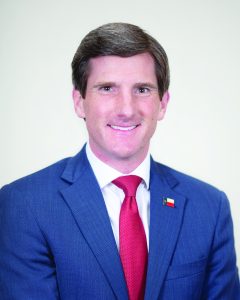Without the state constitutional amendment that Rep. Brooks Landgraf will sponsor in next year’s legislative session, the six public school districts in Landgraf’s District 81 will get no bigger of a share of oil and natural gas severance tax revenues than they have now.
Landgraf said Article 3, Section 49-G of the Texas Constitution specifies the apportionment formula that divvies up the beaucoup oil and gas money that the Permian Basin sends to Austin each month and that he will seek voters’ approval of a fairer system.
“Under the current law, we won’t benefit more than any other school districts,” the Odessa Republican said Tuesday. “However, the increased production will lead to increases in the amount of property tax revenues.”
Along with the Ector County Independent School District, Landgraf represents the districts of Kermit, Wink-Loving, Monahans-Wickett-Pyote, Grandfalls-Royalty and the Barstow part of the Pecos-Barstow-Toyah district.
The Texas Oil & Gas Association says oil producers sent the state comptroller’s office in Austin a record $666 million and natural gas producers $339 million for April before oil paid $595 million and gas $413 million for May from their respective 4.6- and 7.5-percent severance tax levies.
ECISD got $299 million from the state for the previous biennium and $311 for the current two-year period, Superintendent Scott Muri said.
Having served 7 1/2 years in the Texas House of Representatives in Austin, Landgraf said neither the University of Texas Permian Basin nor Odessa College get severance tax money, so called because it’s derived from the extraction of non-renewable natural resources, but are financed from the state’s general fund.
The state gave UTPB $67.5 million for the previous biennium and $71 million for the current one while Odessa College received $19.3 million and $19.7 million, officials said.

Landgraf said UTPB suffers from the same humble stepchild status as the other relatively small schools in the UT System. “Even an Aggie like me can recognize that the flagship campus in Austin gets everything it needs or desires while the smaller schools like UTPB have to fight and scrape for the leftovers,” he said.
“It’s a struggle that is as old as the UT System. UTPB has tremendous growth potential and (president) Dr. Woodley has demonstrated amazing leadership to prioritize her resources and keep doing what needs to be done. That’s why I was pleased in the last session to get $44 million in tuition revenue bonds to renovate the Mesa Building, which is almost 50 years old and has outgrown its original purpose.
“UTPB serves a student population that looks like Texas, many of them first-generation college students. It has a lot more growth potential than UT Austin does. I’ll continue to make sure the needs of our higher education institutions and school districts in the Permian Basin get what they need from the state, even if we have to get creative about the sources.
The UT and Texas A&M systems benefit greatly from the oil- and gas-fueled Permanent University Fund.
“I’ve been successful in cutting down on the liability for Robin Hood payments for West Texas school districts and my goal is to get rid of that imbalance altogether,” Landgraf said. “Larger districts like ECISD no longer have the Robin Hood payments. Allowing our school districts to keep more of the money they’re generating is something I will continue working on.”
Asked if the state has exploited West Texas oil and gas reserves to the benefit of the big cities while begrudgingly returning only a tiny part of the money to the region, Landgraf said, “Yes, it has definitely turned out that way.
“That’s why we need a constitutional amendment for a fair and equitable investment by the state for public education, infrastructure and public safety in the communities that give so much wealth for our state.”
He said the crux of the dilemma is the legislature’s formula basing funding on population. “The population distribution model does account for the irregularities, which make it hard for the West Texas school districts to recruit teachers and our colleges to recruit faculty,” Landgraf said.
In an aside, the 41-year-old attorney said the Odessa District of the Texas Department of Transportation only averaged $51 million in annual funding during the four years before he took office, but that grew to $158 million annually during the next four years and it has improved to $360 million a year in the 3 1/2 years he has been vice chairman of the House Transportation Committee.
Landgraf chairs the oil- and gas-related House Environmental Regulation Committee and he is a member of the House Administration Committee and the select committees on constitutional rights and remedies and youth health and safety.




